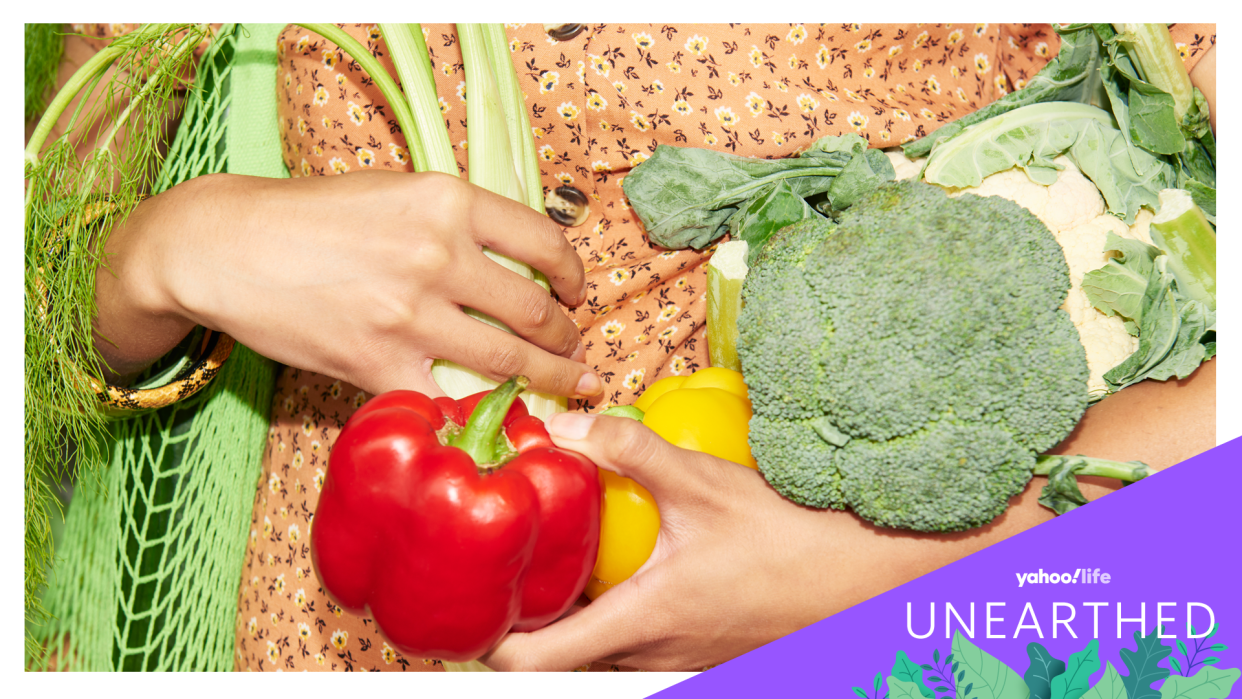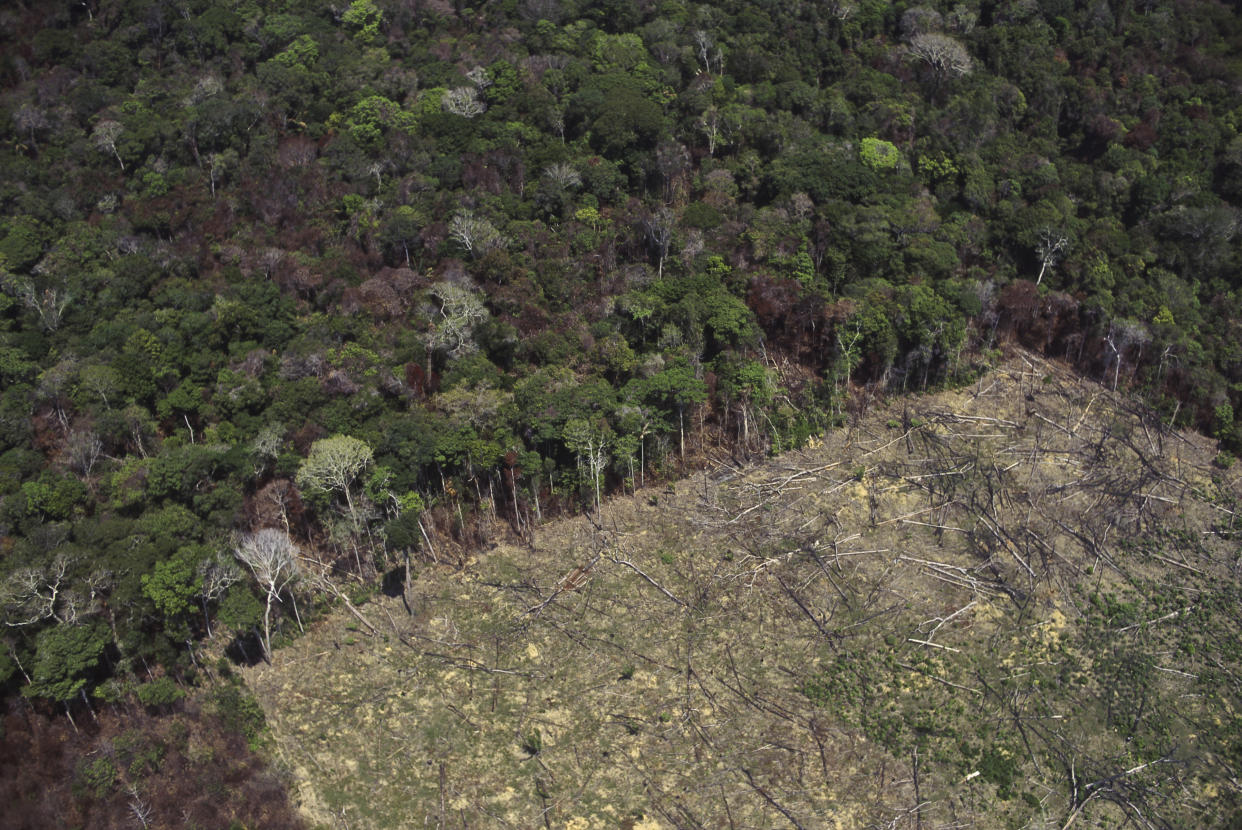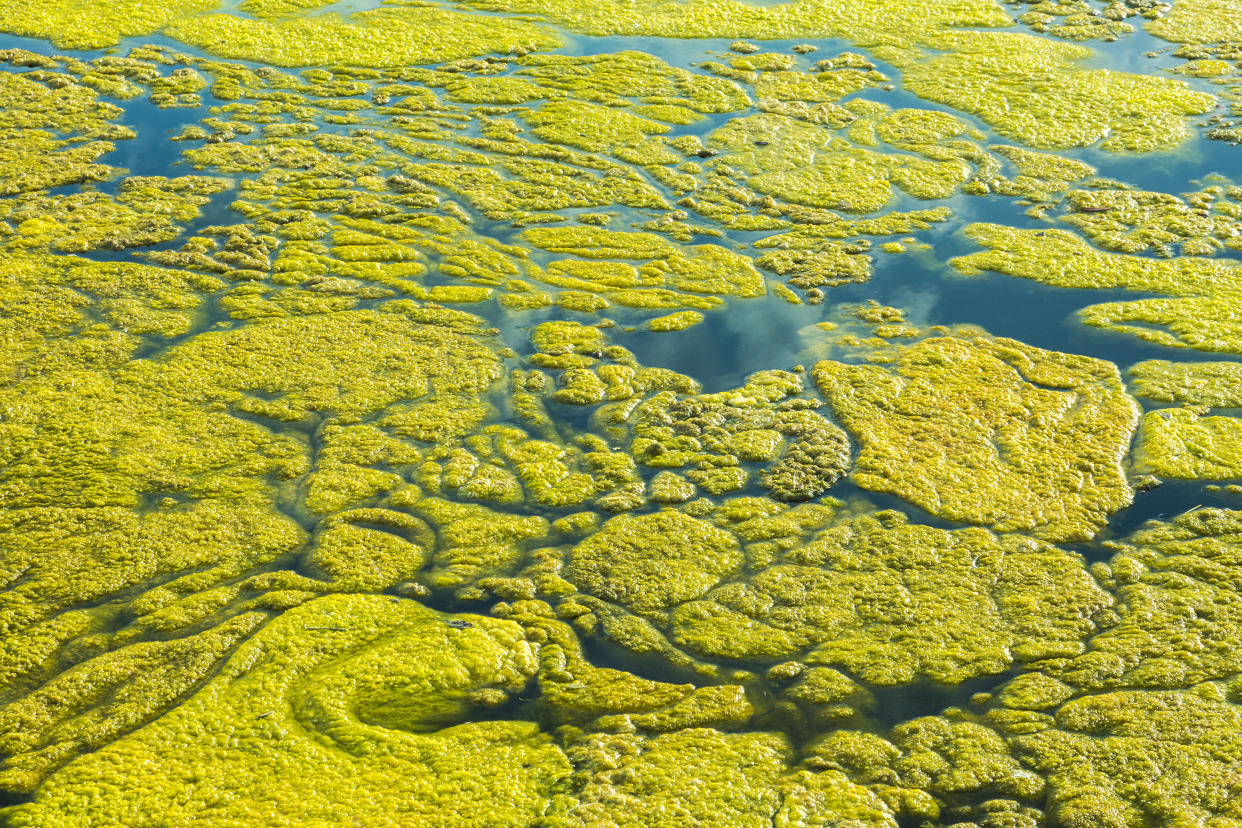Is going vegan really the way to stop climate change? Here's why some say it’s better than 'cutting down on your flights or buying an electric car.'

In Unearthed, Yahoo Life discusses some of the most pressing issues facing our planet — and reveals what you can do to help make a real difference.
First, the good news: Veganuary, the annual worldwide go-vegan campaign happening now in an aim to aid the ailing planet — held every January since 2014 — has made an impact.
By going vegan for just a month, according to the campaign, the cumulative million-plus participants have saved an estimated 1.6 million gallons of water (equal to flushing a toilet about a half million times) and 103,840 tons of carbon emissions (equal to driving around the world about 15,000 times) — not to mention 3.4 million animals.
Plus, the newfound eating habits tend to stick, according to this year’s Veganuary strategy report, which notes: “Participants report that they continue to reduce their consumption of animal products even after January, and food companies keep a larger and better variety of plant-based options on the shelves after successful product and menu launches during Veganuary.”
In 2020, science journal the EAT-Lancet Report, indeed found that by “transforming eating habits, improving food production and reducing food waste” — admittedly a tall order — it is entirely possible to feed a future population of 10 billion people “a healthy diet within planetary boundaries.”
So, what’s the bad news? Brace yourself: There’s a lot.
That’s because animal agriculture is one of the largest sources of global greenhouse gas emissions, with direct connections to mass deforestation, pollution, hunger, antibiotic resistance, species extinction and more.
Some sobering facts: Meat and dairy provide only 18% of the calories humans consume but use 83% of global farmland and are responsible for 60% of all agriculture’s greenhouse gas emissions, according to a 2018 watershed study from University of Oxford food sustainability researcher Joseph Poore.
Further, his research found, farmed animals occupy 30% of the planet’s ice-free land and consume roughly the same percentage of all fresh water.
Livestock farming is responsible for a large share of greenhouse gas emissions. Although the specific percentages vary greatly depending on the source — from 14.5%, according to the Food and Agriculture Organization of the United Nations (FAO), to 26% as found by Poore, and as high as 51%, according a recalculation of FAO’s finding’’ from the now-defunct environmental World Watch Magazine, which calledout the FAO for its private sector partnerships with the meat, poultry, egg and dairy industries — we’re talking about more annual greenhouse gas emissions than all global transportation combined.
“Very simply, even if we were to stop fossil fuel emissions immediately, today, emissions from our feeding systems alone would take us past the 1.5 degrees Celsius [34.7 degrees Fahrenheit],” says Nicola Harris, spokesperson for the global grassroots Plant Based Treaty, referring to the Paris Agreement on climate change goal — to limit global warming to well below 2, preferably to 1.5 degrees Celsius, compared to pre-industrial levels. “If we’re serious about the Paris Agreement and combating the climate emergency,” Harris tells Yahoo Life, “we have to take action on fossil fuels and the feed system in equal measure.”
If this is all news to you, it might be because, according to a 2021 New York University study, the world’s biggest meat and dairy companies have spent a large amount of time, money and effort “into downplaying the link between animal agriculture and climate change, and into fighting climate policy more generally.” The report claims they’ve done it by lobbying Congress and the Environmental Protection Agency to block legislation that might limit production and by funding research that minimizes the link between climate change and animal agriculture, something explored further in the 2021 documentary Eating Our Way to Extinction.
This has led Poore to an insight that's become a touchstone for activists: “A vegan diet is probably the single biggest way to reduce your impact on planet Earth, not just greenhouse gases, but global acidification, eutrophication [excessive plant and algal growth that lowers oxygen levels in water], land use and water use,” he said. “It is far bigger than cutting down on your flights or buying an electric car.”
Here’s a breakdown of how animal agriculture is damaging the planet, and how to make positive change.
Deforestation
In what were once pristine stretches of Amazon rainforest are now millions of farms related to animal agriculture — land cleared of trees either for grazing cattle or to grow grain that is then shipped around the world to feed livestock.

Poore, who was unavailable to speak with Yahoo Life but pointed to a recent YouTube lecture he presented on his findings, explains in that video, “Most of this deforestation has been for beef for the local South American market and for soy to feed pigs, especially in Asia.” To put it another way, he said, “The deforestation of the Amazon rainforest has largely taken place because many humans prefer the taste of animal proteins to vegetable proteins.”
Using satellite data to track annual tropical forest lost to agriculture since 2000, Poore and his researchers found the planet has lost an area equal to the size of the “U.K., Belgium, Germany, the Netherlands and Poland combined” — all of which has released massive amounts of carbon dioxide into the atmosphere, threatening 13,000 known species with extinction.
Deforestation is also meant to be permanent. “When the animals finish grazing, they light pasture maintenance fires to prevent the forests from coming back,” Dr. Sailesh Rao, founder and executive director of Climate Healers and producer of climate-focused documentaries including Cowspiracy, tells Yahoo Life.
Eutrophication
Once forests are cleared and crops to feed cows and pigs are planted, the fields are typically sprayed with nitrogen fertilizer, which sends toxic run-off into water sources and, eventually, the ocean, causing algae blooms that choke marine life and create so-called dead zones, where nothing can survive. Agriculture is a leading cause of oceanic dead zones, according to the EPA.

“Since the demand for meat has grown, these low-oxygen dead zones have been growing and growing,” Sylvia Earle, former chief scientist of the National Oceanic and Atmospheric Administration, said in the documentary Eating Our Way to Extinction. “‘OK,’ people say, ‘that’s too bad for the fish,’ ... but we need to understand that what we do to the ocean, we’re doing to ourselves.”
Poore found that food production causes about 80% of eutrophication — including in a dead zone in the Gulf of Mexico that is “almost the size of Belgium, that doesn’t have enough oxygen for fish.”
Since the 1950s, the documentary states, referencing a Nature journal study, the planet has lost almost 90% of all species of large fish in the ocean — the leading cause of which is overfishing, with a third of all edible fish caught in the ocean now being fed to livestock and farmed fish (which can create more methane than cows, notes Poore). “While some believe switching from a meat- to fish-based diet will help the planet,” notes the film’s narrator, Kate Winslet, “this simply could not be further from the truth.”
Toxic emissions
According to a recent study published in the PLOS Climate journal, ending meat and dairy production would “pause” the growth of greenhouse gas emissions for 30 years, effectively canceling out emissions from all other economic sectors. That’s because animal agriculture is responsible for 65% of the world’s nitrous oxide emissions, and 33% of methane emissions, as was calculated by the U.N. in 2021. “Animal farming is the largest cause,” says Harris. “And what we know is we need to cut it by about 45% a decade to even have a chance of the 1.5 [Paris Agreement] target.”
Carbon dioxide is more complicated, Harris says, because different studies show different numbers. “But what we do know is our feeding system, overall, is responsible for a third of human-caused greenhouse gas emissions, and the largest contribution is from animal agriculture," Harris says. "It’s also the largest driver of deforestation. So we’re not only looking at direct emissions from animals, but carbon going back into atmosphere [from deforestation] ... with 83% of farmland used for raising animals but offering just 18 percent of our calories.”
Human fallout
While people go vegan for many reasons, from animal welfare to health to wanting to help the planet, it’s common to keep such reasons siloed, points out Isaias Hernandez, founder of Queer Brown Vegan, a platform focused on educating how “social, racial and environmental issues are deeply interconnected.”
Hernandez, who recently appeared with Billie Eilish, who is vegan, in a Vogue video about climate change, grew up food insecure in California’s San Fernando Valley, going to food banks and driving half an hour to get to the nearest grocery store offering fresh produce, eventually learning the term “food desert,” he explains. “I saw that racism was deeply interconnected into food systems,” Hernandez tells Yahoo Life.
As an environmental science major at University of California Berkeley, Hernandez and his fellow students “talked about the fact that so many migrant farm workers choose to pick produce, as it’s less traumatic than slicing animals, which is a truly traumatic process,” Hernandez says, “and how it leads to mental health issues for people of color, or Latinos, like myself, including high rates of PTSD.”
Furthermore, he says, much of the environmental destruction wrought by animal agriculture disproportionately affects indigenous lands and communities of color — including through manure pollution and runoff into Black and brown communities, “which then becomes a children’s issue, with high rates of asthma, like near North Carolina hog farms.” The bottom line, Hernandez stresses, is that “veganism was a way for me to divest away from this extractive system,” and to highlight that “these systems are products of colonialism and white supremacy.”
What we can do
Harris believes that if more people truly knew the facts, they would make changes. “I’m not sure enough people understand the gravity of the situation and how dangerous the emergency is, and we need more politicians to communicate it,” she says. Because other causes of the climate crisis have gotten through, she said, with people learning to turn off lights, walk instead of drive and recycle, she’s hopeful.
“The biggest individual action you can take is to adopt a vegan diet,” Harris says. “There isn’t time for baby steps. This is, like, a do-or-die decade. What we do in the next couple of years will determine future of planet ... so we need to do everything and we need to do it now.”
To get there, activists stress the importance of learning about all the reasons for going vegan — including intense and wide-scale animal suffering. “I think everyone has their own individual motivating factors to go vegan,” says Harris, who was first moved to change her diet after seeing horrific undercover footage from slaughterhouses — similar to the 49% of Veganuary participants who told the campaign that animal welfare was their driving factor. "But I took it upon myself to learn about all the different reasons — the climate crisis, food deserts — and you realize everything is interconnected,” she says.
To get started, Rao stresses, “Find help. … You must know someone in your circle who is vegan. Have them as a buddy” for shopping, cooking and eating tips. Support can also be found through vegan “buddy” programs, social media, published starter guides including Main Street Vegan and the Veg News Guide to Being a Fabulous Vegan. There’s also a wealth of information on the Veganuary website.
Beyond changing personal diets, activists stress the importance of supporting policymakers who are looking to alter the systemic problems of animal agriculture. “Trying to bring out city-level changes, and in schools, prisons and universities, is key,” says Harris.
Poore sees room for that happening through government incentives for farms to be more responsible, as well as through digital tools that would allow farmers to measure their impacts and alert consumers to the footprint of their food choices as they shop.
Rao agrees that making systemic change is key, and says he’s been “thrilled” to see plant-based policies created by vegan New York City Mayor Eric Adams, for example, who brought default-vegan menus to city hospitals and “vegan Fridays” to public school cafeterias. “To me, it’s a breakthrough of an institutional leader saying these things,” he says. “That gives me a lot of hope and faith in the future.”
Wellness, parenting, body image and more: Get to know the who behind the hoo with Yahoo Life's newsletter. Sign up here.

